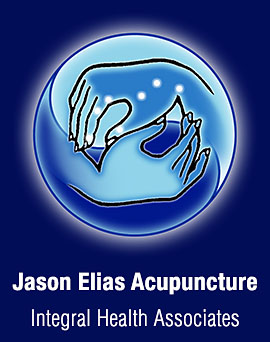WESTERN INTERPRETATION
A term that covers more than a hundred different joint diseases, arthritis is defined as inflammation of a joint or joints, with related symptoms such as redness, swelling, tenderness, and stiffness in the affected joints. Onset is usually very subtle and gradual. In the first stage of the disease, you may experience morning joint stiffness, which typically disappears as you begin to move around. Months or years later, the stiffness is more widespread, and throbbing or stabbing pains migrate from one affected joint to another.
Nearly forty million Americans (one in seven) experience symptoms of arthritis, one of the most widespread of all chronic illnesses. Every year they spend $25 billion on diagnostic tests, medications, doctor visits, and hospital stays; this figure does not include the many millions of dollars spent each year on complementary treatment strategies such as herbal therapy, acupuncture, and nutritional supplements.
The two most common types of arthritis are rheumatoid arthritis and osteoarthritis.
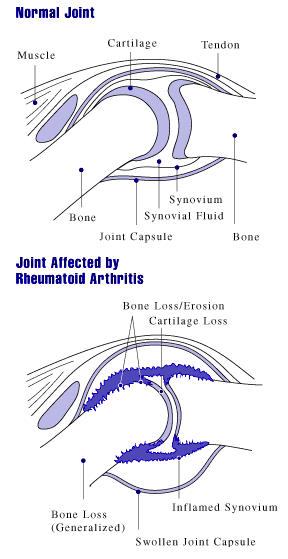 Rheumatoid arthritis: More than two million Americans suffer from this progressive joint disease, which is most common in people twenty to forty years old and afflicts more than twice as many women as men. Symptoms include stiff, sore joints, usually in the fingers, wrists, knees, ankles, or toes, and swelling, redness, and tenderness in the soft tissue surrounding the affected joints. Fatigue and low-grade fevers are also common.
Rheumatoid arthritis: More than two million Americans suffer from this progressive joint disease, which is most common in people twenty to forty years old and afflicts more than twice as many women as men. Symptoms include stiff, sore joints, usually in the fingers, wrists, knees, ankles, or toes, and swelling, redness, and tenderness in the soft tissue surrounding the affected joints. Fatigue and low-grade fevers are also common.
Rheumatoid arthritis is considered an autoimmune disease, a term used to describe those conditions in which the body systematically attacks its own tissue, misidentifying “self” as enemy. Although the cause is unknown, food allergies, emotional disturbances, the accumulation of toxic chemicals in food and water, and lifestyle factors such as excessive exercise or a complete lack of exercise are thought to provoke or aggravate the disease. There is also a strong genetic predisposition involved in this disease.
The course of the disease is unpredictable, and symptoms often stop abruptly, only to recur again unexpectedly. Without proper care and early treatment, permanent deformity and immobility of joints may occur.
Osteoarthritis: Also called degenerative joint disease, osteoarthritis is most likely to strike the large, weight-bearing joints that receive the most use or stress over the years-the knees, shoulders, hips, joints of the big toes, joints of the lower part of the spine, and the distal joints of the fingers (most commonly in women). Characterized by disintegration of the cartilage covering the ends of the bones, osteoarthritis causes pain, stiffness, and in some cases, crippling deformities in nearly sixteen million Americans. Osteoarthritis is considered part of the normal aging process and occurs in approximately 80 percent of adults over the age of fifty.
WESTERN TREATMENTS
Medications: Anti-inflammatory drugs are taken to relieve pain and inflammation. Aspirin is the most commonly used, but since the amounts needed for symptom relief tend to be high, toxic reactions can occur, including gastric problems and tinnitus (ringing ears). Other medications include nonsteroidal anti-inflammatory drugs (NSAIDs) such as ibuprofen, indomethacin, and naproxen; but these drugs may produce unpleasant and potentially serious side effects such as headaches, fever, fatigue, allergic reactions, hypertension, blood count abnormalities, and liver disease. Side effects are most likely to occur with high dosages and long-term use.
Steroidal anti-inflammatory drugs (corticosteroids) may be used on a short-term basis for severe symptoms. Steroidal and nonsteroidal creams and ointments such as aspercreme or cortisone cream applied to the affected joints offer some relief from the pain, swelling, and tenderness. Ben-Gay, Tiger Balm, and other blood-circulating agents may help to increase circulation in the inflamed area.
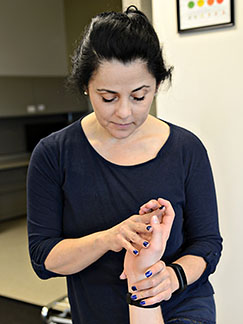 Physical therapy: Applying cold or moist, warm compresses to the affected joints can help relieve the swelling and pain. In general, warm compresses seem to work well in relieving symptoms of stiffness and dull pain, while cold compresses or ice packs are preferred for sharp, stabbing pain and inflamed tissues. Treatments generally last ten to twenty minutes and can be repeated every four hours.
Physical therapy: Applying cold or moist, warm compresses to the affected joints can help relieve the swelling and pain. In general, warm compresses seem to work well in relieving symptoms of stiffness and dull pain, while cold compresses or ice packs are preferred for sharp, stabbing pain and inflamed tissues. Treatments generally last ten to twenty minutes and can be repeated every four hours.
Ultrasound, a technique that uses high-frequency sound vibrations to increase blood supply to a particular area and promote lymphatic drainage from the region, is effective for both rheumatoid and osteoarthritis. Research confirms that ultrasound increases joint mobility, improves blood circulation, and reduces pain.
To keep the joints flexible and mobile, physical therapy may include “passive exercises” in which the therapist gently moves the affected joints to enhance circulation and increase range of motion.
Lifestyle changes: If the patient is overweight, weight reduction techniques can help relieve pressure on the joints.
Proper sleep and rest during periods of severe inflammation are often recommended. Psychotherapy: Because emotional disturbances are thought to aggravate arthritic conditions, psychotherapy may be suggested.
 TRADITIONAL CHINESE INTERPRETATION
TRADITIONAL CHINESE INTERPRETATION
Traditional Chinese medicine considers all varieties of arthritis as symptoms of blockage in the flow of energy and/or blood. The Chinese believe that pain and obstruction are intimately linked; if there is an obstruction, there will always be associated pain, and if there is pain, the practitioner immediately seeks out the underlying obstruction.
Arthritis is often referred to as Bi Syndrome; bi means obstruction. Although anyone can get arthritis, the Chinese believe Wood and Water types are most vulnerable because of their proclivity to blocked or obstructed energy. Wood energy is prone to obstruction and stagnation (constrained Liver chi), while Water energy has a tendency to freeze and solidify; if the underlying imbalance in Wood or Water energy is not corrected, arthritic conditions often develop.
The Chinese believe that four of the Five Devils or pathogenic forces-Wind, Damp, Cold, and Heat-invade the body, causing obstructions and eventually creating arthritic conditions. Each type of blockage involves different symptoms:
- Wind Bi involves moving or migrating sensations of pain. Wind is the energy associated with the Liver and Wood energy.
- Damp Bi involves a dull, heavy pain that tends to be localized and stationary. Damp weather and/or abrupt barometric changes exacerbate the pain. Dampness is most often associated with imbalances in the Spleen/Stomach orb and Earth energy.
- Cold Bi involves severe cramping pains, often described as a “drilling” sort of pain that is fixed in a specific area or areas. Cold is associated with the Kidney and Water energy.
- Heat Bi involves pain characterized by an intense burning quality, with redness and swelling around the affected joints. Heat and inflammation are considered disturbances of yang energy, and the Large Intestine (the domain of Metal) is the organ most directly associated with this condition.
COMPLEMENTARY TREATMENTS
Diet
Food allergies or sensitivities often play a significant role in both rheumatoid arthritis and osteoarthritis.
- The typical Western diet, rich in chemical additives, sugars, excess fats, and refined carbohydrates, can weaken the body’s defensive energy (the wei chi), allowing pathogens to invade the joints. To help prevent and/or reverse arthritis, make sure your diet is rich in complex carbohydrates and fiber, with plenty of fresh vegetables and fruits. Gently steaming your vegetables will help break down the tough cellulose coating and make them easier to digest.
- Because acidic buildup in the joints is often connected with arthritis, avoid foods such as red meat, poultry, and animal fats, which can leave acidic residues in the blood and inflame the joints.
- The nightshade family of vegetables-tomatoes, eggplants, peppers, and potatoes-may aggravate arthritic conditions. Researchers theorize that the solanum alkaloids in these vegetables inhibit collagen repair in the joints. Consume them sparingly or avoid them completely.
- Avoid oranges and orange juice, because the acids in oranges can irritate the delicate joint membranes. Grapefruits and lemons, which are more alkaline in nature, are often well tolerated.
- Drink at least eight to ten 8-ounce glasses of fresh, filtered water daily to help the Liver and Kidneys filter food additives and other foreign chemicals from the blood, thus preventing toxins from accumulating in the joints.
Exercise
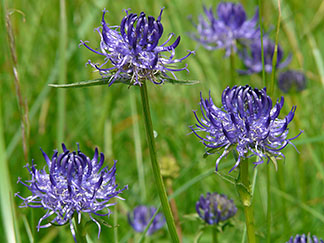
Devils Claw herb
Exercise is critical for all forms of arthritis. During acute flare-ups, physical therapy (passive exercises, ultrasound, and heat and/or cold applications) will keep the blood circulating.
- Walking in the fresh air (or on a treadmill, if the weather keeps you inside) and swimming or exercising in a heated pool will help relieve the pain, enhance your circulation, and replenish your vital energy.
- Because it relies on gentle stretching movements, yoga is a wonderful exercise choice if you suffer from arthritic symptoms.
- Tai chi is an ancient martial art and health-promoting form of exercise that is firmly based in the Taoist philosophy of balance, harmony, and healing from the inside out. The fluid, graceful movements help to invigorate circulation and open up the acupuncture channels to stimulate the flow of chi. As with all exercises for arthritis, honor your limits and don’t push yourself too hard; with time and repeated practice, you’ll find your limits expanding.
In general, we suggest twenty to thirty minutes of exercise daily; adjust the intensity of exercise to your level of pain and degree of inflammation.
Massage is helpful for all types of arthritis because it promotes better circulation and helps the lymph system eliminate toxins from the body. Swedish massage, Rolfing, postural integration, and muscular therapy are particularly effective at breaking up stagnation in the muscles and tendons and promoting lymphatic drainage. The Alexander technique, a unique form of bodywork, teaches ways to change habitual postures or body movements that interfere with the natural flow of energy.
Gentle massage will also ease the pain and reduce the swelling of arthritis. To avoid irritating the skin, lubricate your hands and fingers with massage oil or cream. (Vegetable oil works just as well.) Use long strokes and gentle pressure around (not directly on) the painful or swollen joints.
Sinus Cleanse
In studies conducted in Japan, researchers report that people with autoimmune diseases often have chronic sinus infections (frequently asymptomatic), which can complicate or exacerbate their condition. Periodic sinus cleanses may actually help to calm down a hyper-reactive immune system and ease the symptoms.
We recommend a variation of a cleanse suggested by Japanese acupuncturist Kiiko Matsumoto. Put a teaspoon of sea salt and a pinch of baking soda in a cup of lukewarm water, mix well, and pour a small amount of this solution into the cupped palm of your hand. Gently inhale through each nostril, moving your head around to circulate the saltwater solution. Let the water drain out of your nose, or spit it out of your mouth; gargle with the remaining solution, and spit it out. Follow this routine once a day.
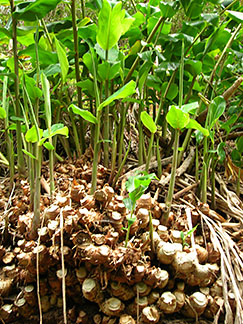
Ginger Plants
Nutritional Supplements
- Omega-3 fatty acids (eicosapentaenoic acid or EPA): These anti-inflammatory agents have general supportive effects on the circulatory system and a specific ability to reduce blood cholesterol levels. Omega-3’s reduce the joint stiffness and soreness caused by rheumatoid arthritis and improve flexibility. They are found in cold-water fish such as salmon, mackerel, herring, anchovies, sardines, and tuna. Eat two or three servings offish weekly, or take a 1,500-mg. supplement daily.
- Gamma linoleic acid: GLA has well-documented anti-inflammatory actions and a balancing effect on the immune system. As many researchers and clinicians theorize, arthritis and other autoimmune diseases are caused in part by the body’s inability to manufacture GLA and other essential fatty acids. So this is a particularly important supplement for arthritis patients. GLA is available in oil of evening primrose, borage seed oil, and black currant seed oil. Take 1,500 mg. daily. GLA and omega-3’s work well together and are often found in combined formulas. Whether you take them separately or in one formula, make sure you get 1,500 mg. of each daily.
- Vitamin C: This vitamin stimulates the immune system, fights free radicals (molecular fragments that attack healthy cells), soothes inflamed tissues, and helps maintain healthy connective tissue. Take 2-4 grams (2,000-4,000 mg.) daily.
- Vitamin E: This powerful antioxidant protects the cell walls and joint linings by destroying free radicals, which can attack the joints in arthritic conditions. Take 400 LD. of d-alpha tocopherol daily; if pain is chronic and persistent, increase to 800 LD. daily.
- Selenium: Selenium stimulates the antioxidant and immune-enhancing effects of vitamin E, as well as antibody formation. Take 200 mcg. daily with vitamin E.
- Vitamin B6 and Vitamin B5 (pantothenic acid): These vitamins have anti-inflammatory actions. Take 50-100 mg. of B6 daily and 100-200 mg. of BS twice daily (200-400 mg. total). Always take any individual B vitamin with a high-potency B-complex vitamin (B-50 or B-lOO).
- Magnesium: Magnesium is considered an antistress mineral, with relaxing effects on both the body and mind. A gentle yet effective muscle relaxant, it relieves muscle cramping and spasms. Magnesium is particularly important for arthritic conditions because it allows calcium to bond into the bone, preventing arthritic deterioration. Take 500-1,000 mg. daily; choose a magnesium supplement that is chelated with amino acids, which means it is easier for your body to absorb.
- Glucosamine sulfate: This nutritional substance is used as a building block for connective tissue. Studies with osteoarthritis patients indicate that it relieves pain, resolves joint tenderness and swelling, and enhances joint flexibility. Take 500 mg. two to three times daily.
- Bromelain: A digestive enzyme derived from pineapple stems, bromelain has strong anti-inflammatory and digestion-supporting properties. In studies with rheumatoid arthritis patients, individuals who took bromelain supplements required significantly lower levels of steroids. Take one tablet approximately half an hour before each meal (three tablets daily).
- Hyaluronic Acid: is an important component of articular cartilage, and has been shown to support the rebuilding of joint cartilage. Supports joint mobility and structure. Take capsules as directed by health care provider.
Herbal Allies
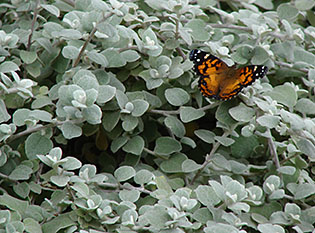
Licorice
Herbal remedies are aimed at treating the individual rather than the disease itself, so the formulas will vary according to individual needs and symptoms. In herbal medicine, the root causes and underlying constitutional issues are always addressed. If a person suffering from arthritis also experiences difficulty digesting and eliminating foods, the herbal formula should include special digestive and Liver-supporting herbs. If heat and agitation-redness, inflammation, burning pain-are involved, select cooling and/or relaxing herbs.
Dozens of herbs are available to help eliminate toxic wastes, reduce inflammation and swelling, and increase circulation to the affected joints. The following herbs are extremely effective for arthritic conditions:
- Celery seed (Apium gruveolens): This cleansing herb has “blood-moving” qualities that help the body eliminate toxins more effectively. Renowned for its ability to assist the body in eliminating uric acid and other acid accumulations via the Kidneys, celery seed has been used to treat arthritis for hundreds of years.
- Devil’s claw (Harpagophytum procumbens): This traditional African and European remedy is most often used for its gentle but powerful anti-inflammatory actions; in one study, nearly ninety percent of subjects taking devil’s claw experienced increased mobility in their joints and a significant reduction in pain and morning stiffness.
- Yarrow (Achillea millefolium): This herb acts as a powerful circulatory tonic and diuretic, helping the body eliminate toxic wastes through the urine.
- Ginger (Zingiber officinalis): A warming, nourishing herb, ginger acts as a circulatory tonic, helping the blood move freely through the joints to flush out toxic wastes. Ginger also helps the digestive system work more efficiently, breaking down proteins and other food products that can aggravate arthritis.
- Licorice (Glycyrrhiza glabra): This all-purpose herb with natural anti-inflammatory actions helps the body put out the “fires” in the joints. When used in any herbal formula, licorice (called “the Great Unifier”) helps balance the actions of the other herbs.
You can combine all the herbs listed above or choose any combination of them.
Dosage: If you purchase your herbs in a health food store (either in tincture form or, as dried herbs, in capsule or pill form), follow the dosage instructions on the label. Because herbs in dried form tend to lose their potency rather quickly, be sure to check the label for the expiration date.
For information on preparing your own herbs, please refer to my book, the A-Z Guide to Healing Herbal Remedies.
Complementary Herbal Formulations:
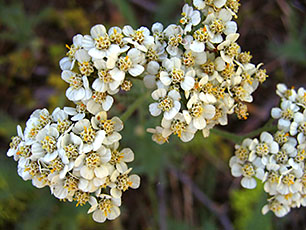
Yarrow
(Traditionally, in both Western and Chinese cultures, the combining of herbs is of superior value than the individual parts. After over thirty years as an herbalist, the synergy of certain herbs became apparent and this understanding has been used to create our own Integral Health Apothecary formulas. We are also listing tradition Chinese herbal tonics which exemplify this synergy.)
- Integral Health Apothecary’s ArthroFlex Formula is designed to support the body’s ability to resolve arthritic symptoms. It is based on the integration of traditional herbal formulas used in different parts of the world, which help in dealing with pain, inflammation and mobility problems in the joints of the body. Ingredients: Boswellia, Devils Claw, Wild Yam Root, Licorice Extract, Turmeric, Crampbark, Celery Seeds, Rehmannia and Glucosamine Sulfate, Guar gum
Chinese Patent Remedies
These famous herbal remedies were formulated for chronic arthritis with gradual onset and/or for arthritis associated with the aging process. As with most Chinese tonic formulas, take the formula until your symptoms subside and your energy returns, then rely on dietary strategies and basic nutritional supplements to maintain good health and ultimate immunity.
- Du Huo and Loranthus Combination (“Angelica Du Huo and Loranthus Formula”): This remedy is used to support the Liver and Kidneys and stimulate the movement of energy and blood through the meridians. The Emperor herb is angelica du huo, which helps to break up stagnating energy in the joints and dispel Wind/Damp. Attending herbs include eucommia bark, codonopsis root, rehmannia root, ginger root, poria fungus, cinnamon bark, loranthus, dong quai, and licorice.
For more acute conditions generally associated with rheumatoid arthritis or acute flare-ups of osteoarthritis, try:
- Clematis/Stephania Formula: For pain, arthritic flareups as recovery from physical injury. Ingredients: Red Peony root, Prepared Rehmannia root, Persica seed, Dong Quai root, Ligusticum (chuan xiong) rhizome, Red Atractylodes (cang zhu) rhizome, Poria sclerotium fungus, Notopterygium rhizome, Citrus peel, Chinese Clematis root, Stephania root, Siler root, Large Leaf Gentian root, Achyranthes root, Fragrant Angelica (bai zhi) root, Fresh Ginger rhizome and Chinese Licorice root.
Acupoints
We’ve selected acupoints on the basis of the individual’s presenting symptoms and the diagnosis of Wind, Cold, Damp, or Heat Bi Syndrome. Additional points are determined by the precise location of the pain and other accompanying symptoms. For help locating these and other acupoints, see Appendix IlL Wind Bi Syndrome:
- Governing Vessel 12 (“Body’s Pillar”): This point supports the wei chi (immune) energy, eliminates the Wind Devil, and strengthens the body, mind, and spirit (as its name implies). It is also said to strengthen the back and support the upper body, and it is therefore especially useful for arthritic conditions that affect the upper back, neck, and head, as well as the shoulders and elbows. Location: Governing Vessel 12 is located on the spine between the third and fourth thoracic vertebrae, approximately at shoulder level.
- Gallbladder 34 (“Yang Mound Spring”): Known as “the influential point for the tendons and sinews,” this point is used for any problem involving tight, strained, or injured tendons. It supports the tendons and joints and helps to ensure the free movement of energy and blood through the tendinomuscular channels. Location: Gallbladder 34 is located on the outside border of the calf, in the depression between the two bones (tibia and fibula).
- Liver 3 (“Great Rushing”): This point is used to keep the energy and blood moving by eliminating Wind and removing various obstructions. Location: Liver 3 is located in the webbing between the big toe and the second toe. Cold Bi Syndrome:
Wet Heating Pads or Moxabustion: This traditional Chinese method, in which an herb or combination of herbs is burned over the affected areas of the body, helps to warm the body/mind/spirit and disperse the Cold. Heat is contraindicated when there is active inflammation of the joints.
Damp Bi Syndrome:
- Stomach 36 (“Walks Three Miles”): This point supports the Stomach and Spleen functions, allowing the metabolic fires to disperse the dampness. Location: Stomach 36 is located three inches below the dimple or depression on the outside (pinky side) of the knee, approximately an inch from the crest of the shinbone, in a groove or natural depression in the muscle.
- Spleen 9 (“Fountain of Yin Spring”): This point is used to clear the body’s waterways of Damp/Heat conditions and replenish yin (fluid) energies. Location: Spleen 9 is located in the depression on the inside of the lower leg, just below the knee. With your knee bent, slide your fingers along the bone on the inside border of the knee until they stop in a natural depression. This point is often extremely sensitive to the touch.
Heat Bi Syndrome:
- Governing Vessel 4 (“Great Hammer”): This point is frequently used to subdue the yang energies of the body, mind, and spirit and to remove Heat from the blood. Location: Governing Vessel 14 is located just below the large protruding vertebra at the base of the neck (the seventh cervical vertebra).
- Large Intestine 4 (“Great Eliminator”): This point helps drain and disperse the “stuck” energy in the upper part of the body, particularly in the head and neck areas. Location: Large Intestine 4 is located in the webbing between the thumb and index finger.
- Large Intestine 11 (“Crooked Pond”): This point is used to disperse Heat from the body and remove obstructions. Location: Large Intestine 11 is located in the lateral (outer) part of the elbow.
Questions to Ask Yourself
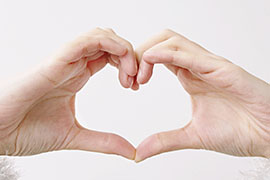 The physical symptoms of pain and discomfort associated with all forms of arthritis may express related problems of blockage or obstruction in the mind and the spirit. Use the following questions to talk to your disease, asking your symptoms what they want from you.
The physical symptoms of pain and discomfort associated with all forms of arthritis may express related problems of blockage or obstruction in the mind and the spirit. Use the following questions to talk to your disease, asking your symptoms what they want from you.
- How do I resist change in my life?
- How do I stop myself from achieving my goals?
- Why am I having trouble standing up for myself?
- What is the worst thing that could happen if I let my feelings out?
Many people with arthritis have a strong affinity to Wood and/or Water. If you are a Wood type, your symptoms might be asking you to address these questions:
- How am I constraining or repressing my energy?
- Where am I blocked creatively?
- Am I turning my anger, frustration, and fear against myself? Am I allowing myself to express these emotions?
If you are strongly influenced by Water energy, ask yourself these questions: • What is my fear preventing me from doing or accomplishing?
- How can I learn to stand up for myself and assert myself with clarity and force?
- Does my physical stiffness have a counterpart in my psyche?
- Am I too rigid in my beliefs and my behaviors?

